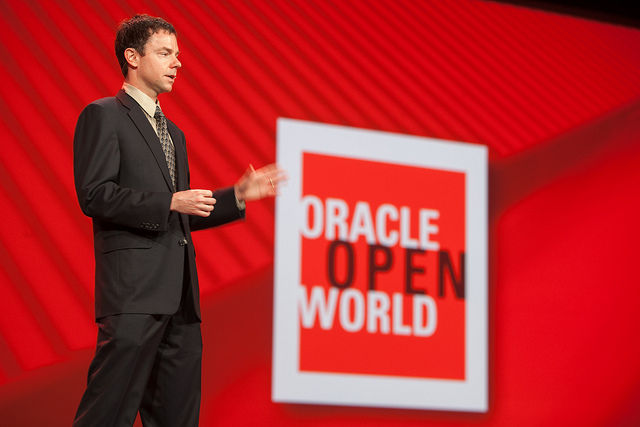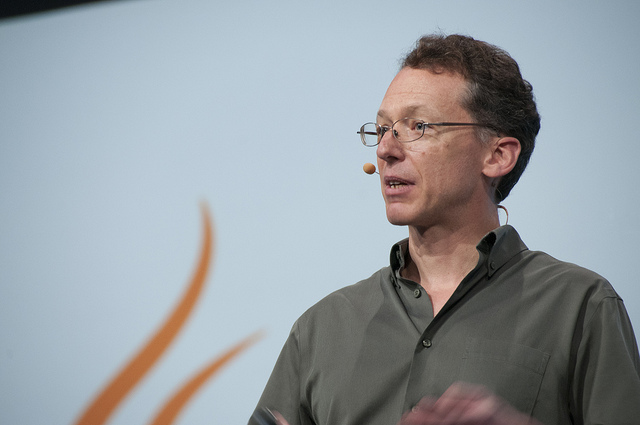
SAN FRANCISCO—Oracle lawyers put two executives and a computer expert on the witness stand in federal court here today, pushing their case that Google violated copyright law when it used Java API packages in its Android operating system.
Following morning testimony by Oracle CEO Safra Catz, the ten-person jury heard from Edward Screven, Oracle's chief corporate architect, who has worked at the company for 30 years. Screven was deeply involved in the company's decision to buy Sun Microsystems in 2009. He was worried that, given Sun's business problems, it wouldn't be able to invest and be a "good steward" of Java.
"Were you in favor of that decision because you thought Oracle could sue Google?" asked Oracle attorney Annette Hurst.
"No," said Screven, making the same point Catz had made on Friday. "It would enable us to grow our business around Java."
Screven was asked about Apache Harmony, the open source product that Google relied on heavily in building Android. He saw a big difference between that project and Android.
Harmony was operating under a spec [specification] license," Screven said. "In order for apache to deliver an independent implementation of Java, they would have to have a TCK license and pass the TCK test," he said, referring to a compatibility test.
"Are you aware of any unlicensed uses of Apache Harmony in the world today?" asked Oracle's lawyer.
"Only one," said Screven. "Only Android."

Next up was Mark Reinhold, Oracle's chief architect for Java SE, who worked at Sun before the acquisition. Reinhold compared Google's copying of declaring code to using key parts of a Harry Potter book.
"It's like using the titles of the books, the headings of each chapter, and the title sentences of each paragraph," said Reinhold, as well as "the connections between the characters."
"Three books later, there are all these deep connections," he continued. "It's intensely creative. Like writing a book, you have to keep a lot of stuff in your head, and the end result is rich and complex. A lot of it is about figuring out what structures you want."
During opening statements, Google's lawyer had compared the declaring code in question to labels on a filing cabinet. Asked if he thought it was accurate to describe Java APIs as labels, Reinhold said that would be "laughably simplistic."

The final witness for the day was one of Oracle's experts, Vanderbilt University professor Douglas Schmidt. Schmidt had created a visual "software map" that showed the APIs at issue in this lawsuit as red lines connecting the implementing code, which was represented as blue and green circles.
"Classes and interfaces are not islands," Schmidt explained. "They’re connected together in an intricate web of relationships."
Schmidt said that Google's use of the declaring code, which he carefully referred to as "Google's copying," didn't alter the design of the 37 Java APIs, which are used in the same way they're used in the Java platform. He also said the APIs are "creative" and "substantial." To push the point, he put up a slide for the jury that displayed three tests he ran on Android after removing the code in question. After each test, the word "FAILED" was written in bright red.
Remove all 37 copied packages—FAILED
Remove individual copied packages—FAILED
Remove copied lines of declaring code—FAILED
Schmidt presented the two slides to emphasize different sets of numbers to the jury. While Google's lawyers talk about "labels" and "declarations" that constitute less than "one-tenth of one percent" of Android's 15 million lines, Schmidt pointed out today that Google wrote about 23 percent of Android code, about 9 percent of which was "blank lines or comments." More than 60 percent was borrowed from third-party sources.
"At the time you did your analysis for this case, you didn’t believe the lang[uage] was free and open, did you?" Google lawyer Mattias Kamber asked on cross-examination.
"I didn't know what 'free and open' meant," Schmidt answered.
"There’s nothing in the 20-year history of java that depicts the software the way you did, with a software map, right?" Kamber asked.
"I don't know," Schmidt said.
Testimony ended, as usual, at 1:00pm sharp. US District Judge William Alsup, who is overseeing the trial, said he expects evidence may be wrapped up by Thursday. The jury has a day off Friday, so closing arguments may take place on Monday.
—————
More from the Oracle v. Google trial:
- Read the Ars Technica explainer on the trial's significance
- Jury selection took place on Monday, May 9
- Lawyers gave opening statements for Oracle and Google on May 10
- Ex-Google CEO Eric Schmidt testified on May 10 and May 11
- Ex-Sun CEO Jonathan Schwartz said he had no problem with Android on May 11
- Android chief Andy Rubin testified on Thursday May 12
- Top Android programmer Dan Bornstein testified on May 13 and May 16
- Google expert Owen Astrachan discussed APIs and fair use on May 16
- Oracle CEO Safra Catz testified on May 16 and earlier today
reader comments
143